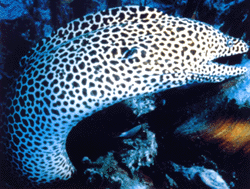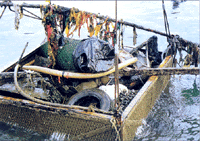Scuba diving has evolved into a major recreational pastime around the world, and the popularity of the sport is also apparent in the United Arab Emirates. The favourable conditions required for recreational diving are all present off the long coastlines of the Emirates.
Whether exploring the sandy bottomed sites of Dubai, Sharjah and Abu Dhabi littered with wrecks and mangroves, or the coral carpets off the East coast, divers are continually surprised at the unexpected richness of the UAE's underwater world.
At a wide variety of locations, divers will find themselves sharing the sea with a vast array of vibrant marine life, including endangered species such as hawksbill turtles and dugongs. There may be no underwater mountain ranges of coral so frequently advertised in diving media about the Maldives or the Red Sea, but the sheer plethora of marine species in the waters of the Arabian Gulf continue to astound even veteran divers. This wealth of aquatic potpourri flourishes in the constantly seesawing temperature changes ranging from 38 degree highs to lows of 14 degrees. Indeed, even the shallow waters and high levels of salinity in the Gulf do not deter the tough denizens of the UAE marine world.
 The most dramatic recreational diving in the area can be found off the East Coast with its multitude of hidden caves, natural harbours, and islands. The sparklingly clean deep waters of the Gulf of Oman shelter a plethora of coral formations. Subjects of Neptune's Kingdom swim alongside you in a brilliant display. As an added bonus, and one which must be close to every responsible diver's heart, is the noticeable lack of damage so often wreaked by human influence.
The most dramatic recreational diving in the area can be found off the East Coast with its multitude of hidden caves, natural harbours, and islands. The sparklingly clean deep waters of the Gulf of Oman shelter a plethora of coral formations. Subjects of Neptune's Kingdom swim alongside you in a brilliant display. As an added bonus, and one which must be close to every responsible diver's heart, is the noticeable lack of damage so often wreaked by human influence.
It is the abundance of magnificent colour, spectacular backdrops and the all important visibility that is immediately noticeable on this coast. Whichever way you move, fish spin away in a glittering frenzy of varied patterns. The picturesque formations of coral are another outstanding feature. Hard, soft and stony corals and countless other organisms create decorative covers as they colonise the natural granite rocks wherever they can get a foothold, forming a cocktail of colour all along the underwater cliffs of the coast.
One of the most popular sites for novice divers is the shallow and easily traversible Snoopy Island, a shore dive just in front of Sandy Beach Motel. It is one of the best night dives on this coast, not only because visitors can swim all the way around the small island in under an hour, but because lights and other equipment can be hired from the dive centre at the motel.
To find true coral reefs, trips to Shark Island, Martini Rock and Dibba Rock will be required. Undisputedly one of the most spectacular sites on the East Coast, Shark Island offers the possibility of sighting the resident leopard or grey reef sharks stealthily gliding past. Every hole, crevice and plateau is home to teeming life as tiny nudibranchs (highly coloured Ôsea-slugs') and sea cucumbers share their underwater arcadia with the omnipresent barracuda and kingfish. Moray eels slide out from under protective overhangs intent on fiercely guarding their territory. Down to depths of 28 meters lavish coral ripples in the mild current and soft corals and hydroids are strewn across the rocky seabed.
Martini Rock is perhaps the most sumptuous of the East Coast's coral gardens. Divers can descend along the underwater cliff face down to 19 metres, observing that every crevice is covered by animated life forms.
Yet another worthwhile dive site is the Car Cemetery, which is an artificial reef built up from a variety of sunken vehicles at a bottom depth of 16 metres. A special delight of this dive is the assurance of sighting graceful seahorses drifting amongst the steering wheels and hub caps.
Many divers actually prefer the more temperate dive sites of the long Arabian Gulf coast of Abu Dhabi and the northern Emirates, especially beginners who are developing their skills. Coral is not in abundance, although one of the most popular sites is the Jebel Ali Reef. Stretching in a south-westerly direction from the Jebel Ali Hotel, this reef is one of the few living coral habitats in this area.
The islands to the west of Abu Dhabi city provide divers with a unique chance to witness the functions of mangrove eco-systems. The mangrove forests provide shelter and nurseries to numerous species before the short journey to the open sea, and also provide a protective territory for the breeding of dugongs, hawksbill turtles and bottlenose dolphins.
The most popular sites in the Arabian Gulf waters remain the fascinating artificial reefs. These formations have been created by ships which have succumbed to powerful Shamal winds or those structures purposefully sunk as inspired ways of adding another dimension to Gulf diving. All manner of wrecks litter the seabed like a monument to the sea-faring past of the Arabian Gulf. Dive operators in Abu Dhabi and Dubai frequently take their thrill seeking clients to favourite sites such as the Dara, the Cement Barge and the Hannan.
Each ship is an adventure in its own right, offering divers a chance to penetrate its shrouded hold and corridors accompanied by fierce looking barracuda and numerous other curious onlookers. The wrecks, as is often the case with sandy-bottomed locations, will act as an orientation point and shelter for not only the colonising organisms, algae and sponges but the resident schools of fish that pulsate around the hulking structures.
It should be noted that professionals recommend specialised instruction for divers who wish to experience the thrills of wreck-exploring. Once forewarned of the potential hazards, even novice divers can poke their noses about in relative safety. Due to the tendency of these waters to contain a proliferation of suspended particles, the best months for visibility can be found just before the hottest summer months between May, June and July and again in September and October.
If the diver wants to graduate from the somewhat tame Gulf waters, then it is time for an expedition to Musandum Peninsula which separates the Arabian Gulf waters from the Gulf of Oman. The vibrancy of underwater life differs considerably between the enclosed body of water and the depths found off the mysterious coastline near the Straits of Hormuz. Many species found there and on the East Coast of the UAE bear distinct similarities to those found as far away as Hawaii and Central America. Divers are beginning to enjoy the spectacular splendours of this particular mountainous coastline on chartered dhow trips. The excursions are often over two or three days, stopping off at various submerged islands along the way or anchoring within the hidden fjords.
 With its variety of delightful dive sites, the United Arab Emirates is ready to dedicate its energy to the promotion of scuba diving as a major tourist attraction. There are some very real dangers, however, which threaten the bright future of this economic sector.
The Arabian Gulf coast off Dubai and Abu Dhabi has already lost many of the coral formations it once boasted. The effects of over-fishing, pollution, irresponsible divers and numerous other human influences have decimated many of the coral reef structures indigenous to the area only thirty years ago.
With its variety of delightful dive sites, the United Arab Emirates is ready to dedicate its energy to the promotion of scuba diving as a major tourist attraction. There are some very real dangers, however, which threaten the bright future of this economic sector.
The Arabian Gulf coast off Dubai and Abu Dhabi has already lost many of the coral formations it once boasted. The effects of over-fishing, pollution, irresponsible divers and numerous other human influences have decimated many of the coral reef structures indigenous to the area only thirty years ago.
Discarded fishing traps, known as gargour, are taken by the current and never reclaimed, but continue to kill. Lost or damaged fishing nets take an enormous toll on the juvenile fish population in these waters.
Layers of pollutants from oil and diesel spills affect the penetration of essential sunlight to the marine life below. The subsequent changes in the food chain, a direct result of damage to the reefs, have long-lasting repercussions on the health and reproduction of marine life in the region as a whole.
A number of active Emirati conservation groups have recently organised beach, creek and seabed clean-ups in a bid to correct a worsening situation. Among them, the Emirates Marine Environmental Group (EMEG) has specialized in tackling marine pollution. EMEG is currently addressing the urgent issues of underwater conservancy and regulated tourism.
"Diving is expanding as a potentially highly lucrative industry", explained Abdul Hakeem Abulhoul, spokesman for the Group. "But the pressures associated with it are also growing. The survival of our unique marine habitat here in the Emirates will depend greatly on how effectively tourism is incorporated into the economy and the parallel promotion of marine conservancy awareness."
EMEG has joined forces with the Dubai Municipality to sponsor the development of specially designed artificial reefs. Several small scale experimental structures have already been sunk, and the resulting explosion of marine biology was so encouraging that a grander effort is now being implemented.
After months of careful preparation, the site for the artificial reef has been designated three miles off Dubai's Mina Seyahi coastline. Slabs of specially treated pre-cast concrete, each weighing approximately five tonnes, are being transported to the site by barge and deposited on the sandy bottom by trained divers in a predetermined pattern. At a depth of around 35 feet, the ecologically sound artificial reefs ensure that within just eighteen months a self-sustaining natural reef eco-system will blossom on the currently barren sea bed.
Within months, the artificial structures will form a habitat far more protective and productive than any method previously used. Kept under constant surveillance and research, the reef's progress will be closely monitored during its infancy in order to regulate fishing rights and diving restrictions.
The safeguarding of the Arabian Gulf's eco-system has been receiving invaluable attention from the authorities. Dubai Municipality have donated some of the funding and other support services for the artificial reef project and continues to take a keen interest in the project.
Jebel Ali's ever dwindling natural reef has recently been surrounded by 100 permanently fixed mooring buoys with the specific intention of designating the area as an officially protected marine reserve.
It remains to be seen if the marine habitat of the United Arab Emirates can withstand the pressures of economic development and tourism.
The partnership of both public and private sectors actively promoting marine conservation and working to avert further damage gives reason to be optimistic for the future of the Emirati underwater treasures.